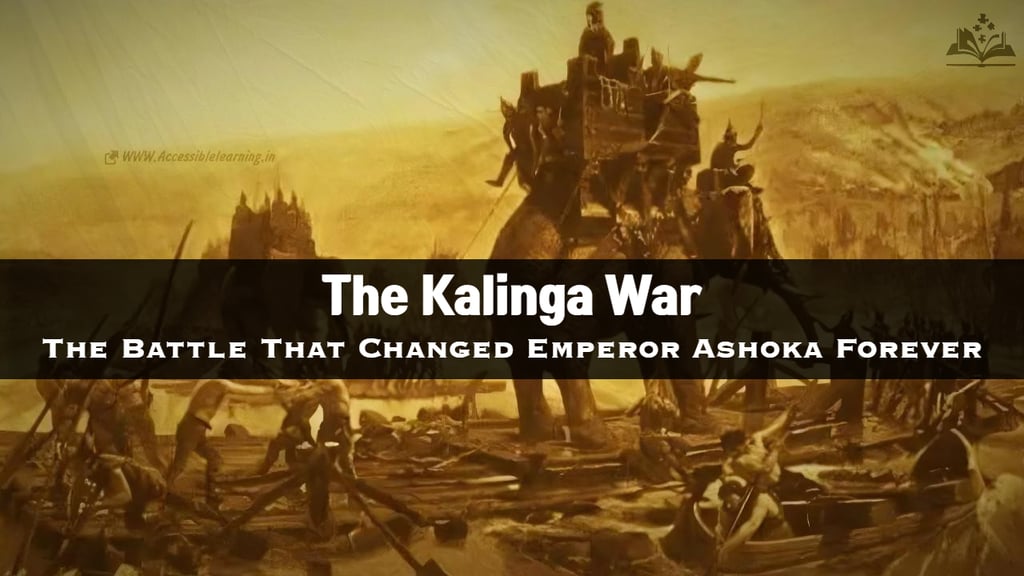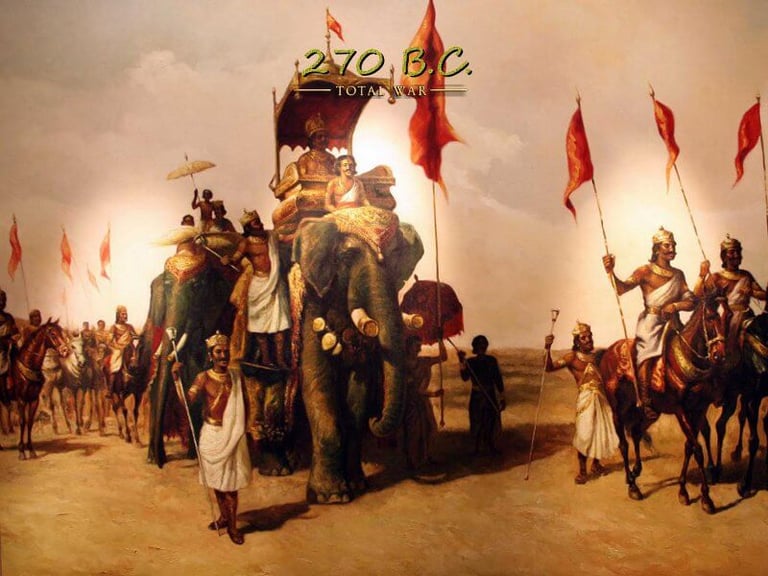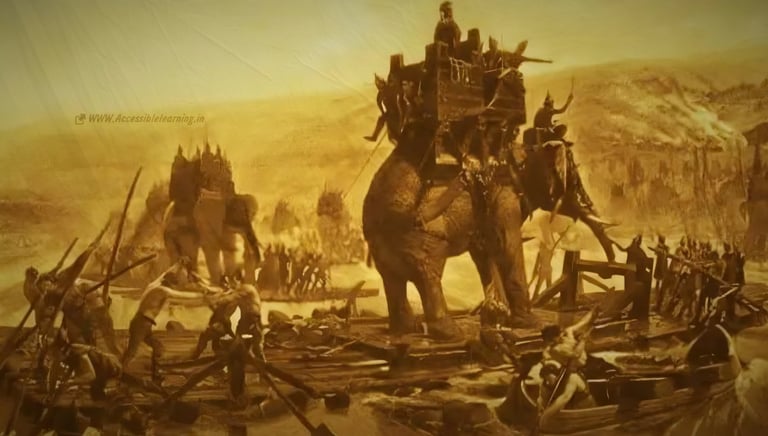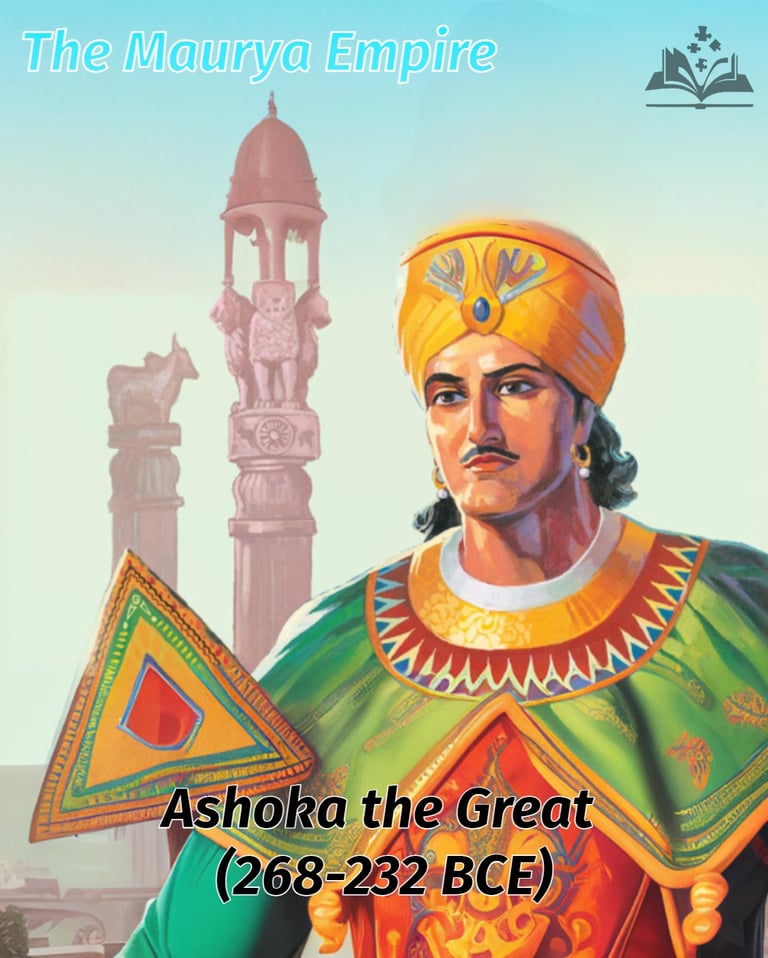
Blood and Enlightenment: The Battle That Changed Ancient India Forever
The Kalinga War of 261 BCE: Explore the epic battle that transformed Emperor Ashok from a ruthless conqueror to a champion of peace and Buddhism. Discover how this watershed moment in ancient Indian history revolutionized governance, changed military doctrine, and left an enduring legacy that resonates to this day.
HISTORYEDUCATION/KNOWLEDGEEMPIRES/HISTORYINDIAN HISTORY
Keshav Jha/Sachin K Chaurasiya
2/26/20258 min read


History often turns on singular moments that transform not just nations, but the human spirit itself. The Kalinga War of 261 BCE stands as one of these pivotal events—a conflict that began as a brutal conquest but ended by giving birth to one of history's greatest experiments in peaceful governance.
The World Before the War
To understand the magnitude of what transpired in Kalinga, we must first paint a picture of third-century BCE India. The subcontinent was experiencing an age of empire-building unprecedented in its history. The Mauryan Empire, established by Chandragupta Maurya/चन्द्रगुप्त मौर्य, had grown to encompass most of South Asia. His grandson Ashoka had ascended to the throne through a succession struggle that historians suggest was particularly violent, even by the standards of the time.
In this landscape of expanding empires stood Kalinga, located in what is now the Indian state of Odisha. Far from being a simple kingdom, Kalinga was a sophisticated maritime power that controlled crucial trade routes along the Bay of Bengal. Its merchants sailed as far as Southeast Asia, carrying not just goods but also Indian culture and ideas across the seas. The kingdom's wealth came from its pearls, precious stones, and elaborate textiles, while its military strength was built upon a powerful navy and the largest elephant corps in the region.
Why Kalinga Mattered
Kalinga's significance went far beyond its material wealth. The kingdom represented something rare in this age of empires—a fierce tradition of independence. Its people had successfully resisted previous attempts at conquest by the Nanda Empire, and this spirit of freedom had become deeply woven into their cultural identity. Their sophisticated society combined urban planning with respect for tribal traditions, and their educational institutions attracted scholars from across India to study astronomy, mathematics, and philosophy.
For Ashoka and the Mauryan Empire, Kalinga represented both an irresistible prize and an intolerable challenge. Its conquest would secure the entire eastern seaboard of India, provide access to vital trade routes, and eliminate the last major independent power on the subcontinent. However, the importance of this conflict would ultimately transcend these strategic considerations in ways no one could have predicted.


The Battle That Changed Everything
The Military Landscape
The Kalinga War of 261 BCE represented military innovation and strategy on an unprecedented scale. The Mauryan Empire brought to bear what ancient records suggest was one of the largest armies ever assembled in ancient India:
A main force of 200,000 infantry soldiers
10,000 cavalry mounted on trained war horses
5,000 war chariots, each carrying three warriors
3,000 war elephants, specially trained for combat
An auxiliary force of 150,000 support personnel
Kalinga's defenders, though outnumbered, were far from helpless. Their forces included:
60,000 infantry troops, many veterans of previous conflicts
A navy of 700 warships controlling the coastal waters
2,000 war elephants, considered among the best-trained in India
An extensive network of spies and informants
Sophisticated defensive fortifications along key routes
Battle Preparations
The months leading up to the main battle saw intense preparation on both sides. The Mauryans established forward bases and supply lines, while Kalinga's defenders prepared their cities and fortifications. Archaeological evidence has revealed:
Extensive earthwork defenses around major cities
Wooden watchtowers placed at strategic intervals
Underwater barriers in rivers to prevent enemy ships
Stockpiles of weapons and supplies in fortified caves
Hidden water reservoirs for prolonged sieges
The Three-Phase Battle
The actual conflict unfolded in three distinct phases over several months:
Phase One: The Naval Campaign
The Mauryan forces first attempted to neutralize Kalinga's naval advantage. They employed:
A blockade of major ports
Attacks on coastal settlements
Destruction of shipbuilding facilities
Deployment of fire ships against Kalingan vessels
Seizure of strategic islands
Phase Two: The Land Invasion
The main invasion involved multiple army groups advancing from different directions:
Northern force moving down the coastal plain
Western force advancing through the hills
Southern force moving up from already conquered territories
Special units targeting known elephant training centers
Phase Three: The Siege Operations
The final phase involved simultaneous sieges of multiple Kalingan cities:
Use of advanced siege engines
Mining operations under city walls
Psychological warfare tactics
Cutting off water supplies
Bombardment with incendiary materials
Military Innovations
New designs for siege engines capable of breaking stronger walls
Improved metallurgy in weapons production
Advanced logistics systems for supplying large armies
Novel tactics for elephant-based warfare
Sophisticated military communication systems
The Human Cost
Beyond the raw numbers of casualties, contemporary accounts describe the profound human impact:
Entire families were separated during forced deportations
Traditional social structures were completely disrupted
Ancient crafts and skills were lost as artisan communities were destroyed
Trade networks built over generations collapsed
Cultural and religious centers were abandoned
Battlefield Archaeology
Recent archaeological discoveries have provided new insights into the conflict:
Mass graves showing evidence of organized burial practices
Weapon caches revealing metallurgical advancement
Destroyed granaries indicating systematic targeting of food supplies
Burned buildings showing patterns of urban warfare
Human remains bearing wounds from various weapons
The Decisive Moment
The turning point came during what historians now call "The Day of the Elephants." This crucial battle saw the largest deployment of war elephants in ancient Indian history. The clash occurred on the plains near the Daya River, where:
Over 5,000 elephants participated in the battle
The fighting was so intense it allegedly caused the river to change course
The battlefield covered an area of approximately 20 square kilometers
The combat lasted from dawn to dusk
Both sides suffered catastrophic losses
Strategic Significance
The battle's outcome had far-reaching military implications:
Demonstrated the limitations of traditional fortress defenses
Showed the importance of naval power in territorial control
Revealed the vulnerability of trade-dependent economies
Proved the effectiveness of coordinated multi-front campaigns
Highlighted the devastating potential of siege warfare
Legacy in Military History
The Kalinga War influenced military thinking in several ways:
Led to new theories about the ethical conduct of warfare
Influenced the development of defensive architecture
Changed how armies approached civilian populations
Affected military recruitment and training methods
Inspired new approaches to military logistics




The Emperor's Awakening
What makes the Kalinga War unique in history is not the scale of its devastation, but what happened next. Ashoka, victor of the battle, walked the battlefield himself. What he saw there—the bodies of the dead, the grieving families, the destruction of a magnificent civilization—affected him profoundly. In his own words, preserved in rock edicts that still stand today: "What have I done? If this is victory, what is defeat?"
This moment of crisis led to what historians call "the great transformation." Ashoka's conversion to Buddhism following the war wasn't a simple change of religion—it represented a fundamental reimagining of what kingship could mean. The emperor who had sought to conquer the world now sought to conquer himself, and in doing so, revolutionized the very nature of governance.
A Revolution in Governance
The changes Ashoka implemented following the war were revolutionary. He established what might be called the world's first welfare state, building hospitals for both humans and animals, constructing rest houses for travelers, and creating sophisticated systems for water management. His administration appointed special officers—the Dhamma Mahamatras—whose sole duty was to promote the moral and material welfare of the people.
But perhaps most remarkably, Ashoka promoted religious tolerance and philosophical diversity in an age when such concepts were virtually unknown. His edicts, carved in stone and still visible today, specifically protected religious minorities and encouraged open dialogue between different faiths. He sent diplomatic missions to distant lands, not to threaten or demand tribute, but to share ideas and establish peaceful relations.


Archaeological Evidence Brings History to Life
Modern archaeology continues to uncover new details about the Kalinga War and its aftermath. Excavations have revealed sophisticated urban centers with advanced drainage systems, hospitals built according to Ashoka's edicts, and trade goods from as far away as Rome and China. These findings help us understand both the magnificence of what was destroyed in the war and the scale of what was built in its aftermath.
Lessons for Our Time
The Kalinga War offers profound lessons for our own age. It demonstrates that military victory can come at an unacceptable human cost. It shows that genuine transformation—both personal and political—is possible even after the most traumatic events. Perhaps most importantly, it provides an example of how governance based on moral principles and concern for all living beings is not just an idealistic dream but a practical possibility.
A Legacy That Endures
The ripples from the Kalinga War continue to spread through history. The principles of religious tolerance, state welfare, and environmental protection that Ashoka implemented following the war would influence societies across Asia. The questions he wrestled with—about power, morality, and the true meaning of victory—remain as relevant today as they were two millennia ago.
In the end, the Kalinga War teaches us that history's greatest transformations can emerge from its darkest moments. It reminds us that the capacity for change—profound, revolutionary change—lies within both individuals and societies. In an age when warfare and environmental destruction threaten our world, this ancient story offers not just inspiration, but practical lessons in how humanity might choose a different path.


Frequently Asked Questions About the Kalinga War
Q: When did the Kalinga War take place?
The Kalinga War took place in 261 BCE during the reign of Emperor Ashoka of the Mauryan Empire.
Q: Where was Kalinga located?
Kalinga was located in present-day Odisha (formerly Orissa) and northern Andhra Pradesh in India, along the eastern coast of the subcontinent.
Q: How long did the war last?
The main campaign lasted approximately eight months, though the entire military operation, including preliminary skirmishes and final pacification, spanned about two years.
Q: How many soldiers fought in the Kalinga War?
200,000 infantry soldiers
10,000 cavalry
5,000 war chariots
3,000 war elephants
Kalinga's forces included:
60,000 infantry
700 warships
2,000 war elephants
Q: What were the casualties of the war?
According to Ashoka's own edicts:
100,000 soldiers died in battle
150,000 were deported
Approximately 100,000 died from wounds and disease
Over 10,000 civilians perished
Q: What weapons were used in the war?
Iron swords and spears
Bow and arrows
War elephants
Siege engines
Naval vessels
Chariots with mounted archers
Historical Impact
Q: How did the war change Ashoka?
The war's brutality profoundly affected Ashoka, leading to his:
Conversion to Buddhism
Abandonment of military conquest
Adoption of "Dhamma" (righteous living)
Implementation of welfare policies
Promotion of religious tolerance
Q: What were the immediate effects of the war?
The immediate consequences included:
Mass casualties and deportations
Disruption of trade routes
Environmental destruction
Cultural displacement
Economic devastation in the region
Q: How did the war affect Indian history?
Spread of Buddhism across Asia
Development of new governance models
Implementation of social welfare systems
Establishment of international diplomatic relations
Creation of a new political philosophy
Archaeological Evidence
Q: What physical evidence exists of the war?
Weapon caches
Fortification remains
Mass graves
Ashoka's rock and pillar edicts
Destroyed urban centers
Q: Where can Ashoka's edicts about the war be found?
Key edicts describing the war can be found at:
Dhauli, Odisha
Jaugada, Odisha
Girnar, Gujarat
Various other sites across India
Cultural Impact
Q: How did the war influence Buddhism?
A: The war's impact on Buddhism included:
Increased royal patronage
Spread of Buddhist missionaries
Construction of Buddhist monuments
Development of Buddhist art
Integration of Buddhist principles in governance
Q: What cultural changes occurred after the war?
Promotion of vegetarianism
Development of peace literature
Growth of religious tolerance
Emphasis on moral education
New architectural styles
Modern Relevance
Q: Why is the Kalinga War still studied today?
Understanding personal transformation
Studying ethical governance
Learning about peace-building
Examining military history
Understanding religious conversion
Q: Are there modern parallels to the Kalinga War?
Post-conflict transformation
Peace-building efforts
Religious tolerance initiatives
Humanitarian governance
Environmental protection policies
Common Misconceptions
Q: Was Ashoka's conversion immediate?
A: No, historical evidence suggests the transformation was gradual, occurring over several years following the war.
Q: Did Ashoka completely disband his military?
No, he maintained defensive forces but abandoned aggressive military expansion.
Q: Was Kalinga completely destroyed?
While severely damaged, Kalinga was rebuilt under Mauryan rule and eventually regained prosperity.
Q: What are the primary sources for studying the Kalinga War?
Ashoka's rock and pillar edicts
Buddhist texts
Archaeological findings
Contemporary Greek accounts
Traditional historical chronicles
Q: Where can one find more information about the war?
Academic publications
Archaeological reports
Museum collections
Historical research centers
Ancient text translations
Subscribe To Our Newsletter
All © Copyright reserved by Accessible-Learning Hub
| Terms & Conditions
Knowledge is power. Learn with Us. 📚


